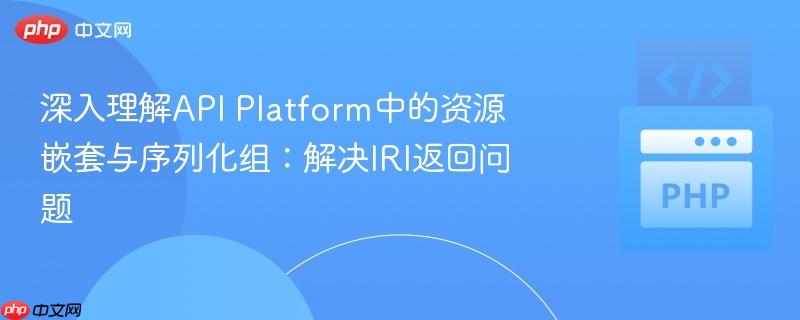
本文深入探讨了symfony api platform中,即使正确配置了序列化组(groups)注解,关联实体仍以iri(国际化资源标识符)形式而非完整对象返回的常见问题。通过分析`normalizationcontext`与`@groups`注解的工作机制,本文将揭示导致此行为的根源,并提供两种有效的解决方案:移除关联实体的`normalizationcontext`或为其定义独立的序列化组,从而实现期望的资源嵌套输出。
在开发API时,我们经常需要返回包含关联数据的复杂资源。Symfony的API Platform框架结合了Doctrine ORM和Symfony Serializer组件,提供了强大的功能来构建RESTful API。其中,序列化组(Serialization Groups)是控制API响应内容的关键机制。然而,开发者有时会遇到一个困惑:即使为关联实体设置了正确的序列化组,API响应中却依然返回关联资源的IRI,而非其完整数据。本文将详细解析这一问题,并提供解决方案。
假设我们有两个实体:AUDField(字段)和 AUDFieldType(字段类型),一个 AUDField 关联一个 AUDFieldType。我们希望在获取 AUDField 资源时,其关联的 AUDFieldType 能够作为嵌套对象被完整序列化,而不是仅仅返回一个IRI。
以下是初始的实体定义:
AUDField 实体
<?php
namespace App\Entity;
use ApiPlatform\Core\Annotation\ApiResource;
use Doctrine\ORM\Mapping as ORM;
use Symfony\Component\Serializer\Annotation\Groups;
/**
* @ApiResource(
* normalizationContext={"groups"={"field:read"}},
* )
* @ORM\Entity(repositoryClass="App\Repository\AUDFieldRepository")
* @ORM\Table(name="aud_field")
*/
class AUDField
{
/**
* @ORM\Id
* @ORM\GeneratedValue
* @ORM\Column(type="integer")
* @Groups("field:read")
*/
private $id;
/**
* @ORM\Column(type="string", length=255, unique=true)
* @Groups({"field:read"})
*/
private $name;
// ... 其他属性和方法 ...
/**
* @ORM\ManyToOne(targetEntity=AUDFieldType::class)
* @ORM\JoinColumn(nullable=false)
* @Groups({"field:read"}) // 期望通过此组序列化AUDFieldType
*/
private $type;
// ... getters and setters ...
}AUDFieldType 实体
<?php
namespace App\Entity;
use ApiPlatform\Core\Annotation\ApiResource;
use Doctrine\ORM\Mapping as ORM;
use Symfony\Component\Serializer\Annotation\Groups;
/**
* @ApiResource(normalizationContext={"groups"={"field:read"}}) // 注意这里的normalizationContext
* @ORM\Entity(repositoryClass="App\Repository\AUDFieldTypeRepository")
* @ORM\Table(name="aud_field_type")
*/
class AUDFieldType
{
/**
* @ORM\Id
* @ORM\GeneratedValue
* @ORM\Column(type="integer")
* @Groups({"field:read"}) // 期望在field:read组中序列化id
*/
private $id;
/**
* @ORM\Column(type="string", length=100)
* @Groups({"field:read"}) // 期望在field:read组中序列化name
*/
private $name;
// ... getters and setters ...
}当我们请求 http://127.0.0.1:8000/api/field/1 时,预期的结果是 type 属性包含 AUDFieldType 的完整对象数据。然而,实际的API响应却如下所示:
{
"@context": "/api/contexts/AUDField",
"@id": "/api/field/1",
"@type": "AUDField",
"id": 1,
"name": "Identifiant",
"specifications": {
"minlength": 4
},
"type": "/api/fieldtype/1", // 仍然是IRI
"attributesTypes": [
"/api/attributetype/1"
]
}type 属性返回了一个IRI (/api/fieldtype/1),而不是一个包含 id 和 name 的嵌套对象。
API Platform在处理资源序列化时,遵循一套特定的逻辑。当一个实体(例如 AUDField)引用另一个实体(AUDFieldType)时,API Platform默认的行为是返回被引用实体的IRI。这是为了避免深度嵌套和循环引用,同时提供一种轻量级的引用方式。
要实现资源嵌套,我们需要依赖Symfony Serializer的序列化组功能。在 AUDField 实体中,我们在 $type 属性上添加了 @Groups({"field:read"}),这表明当 AUDField 在 field:read 组中被序列化时,应该尝试序列化其关联的 AUDFieldType 对象。同时,在 AUDFieldType 实体内部,其 id 和 name 属性也标记了 @Groups({"field:read"}),这告诉序列化器当 AUDFieldType 在 field:read 组中被序列化时,这些属性应该被包含。
问题出在 AUDFieldType 实体顶部的 @ApiResource 注解中的 normalizationContext 配置:
/**
* @ApiResource(normalizationContext={"groups"={"field:read"}}) // 这一行是关键
* @ORM\Entity(repositoryClass="App\Repository\AUDFieldTypeRepository")
* @ORM\Table(name="aud_field_type")
*/
class AUDFieldType这里的 normalizationContext={"groups"={"field:read"}} 意味着当 AUDFieldType 作为顶级资源 被请求时,它会使用 field:read 组进行序列化。当API Platform尝试序列化 AUDField 中的 $type 属性时,它会检查 AUDFieldType 是否是一个API资源,并且是否定义了自己的 normalizationContext。如果 AUDFieldType 自身也定义了 normalizationContext 并且与父资源(AUDField)的序列化组重叠,API Platform可能会默认将其视为一个独立的、可单独访问的资源,从而返回IRI以保持一致性或避免潜在的循环引用问题。
简而言之,AUDFieldType 上的 normalizationContext 告诉API Platform,AUDFieldType 资源本身应该如何被序列化。当父资源试图嵌套它时,这个独立的 normalizationContext 可能会干扰嵌套行为,导致API Platform选择返回IRI。
解决此问题的关键在于正确管理关联实体的 normalizationContext。我们有两种主要策略:
如果 AUDFieldType 实体主要通过其他实体(如 AUDField)进行嵌套暴露,并且不打算作为具有特定默认序列化组的顶级资源被直接访问,那么我们可以移除其 @ApiResource 注解中的 normalizationContext。
修改 AUDFieldType 实体:
<?php
namespace App\Entity;
use ApiPlatform\Core\Annotation\ApiResource;
use Doctrine\ORM\Mapping as ORM;
use Symfony\Component\Serializer\Annotation\Groups;
/**
* @ApiResource() // 移除 normalizationContext
* @ORM\Entity(repositoryClass="App\Repository\AUDFieldTypeRepository")
* @ORM\Table(name="aud_field_type")
*/
class AUDFieldType
{
/**
* @ORM\Id
* @ORM\GeneratedValue
* @ORM\Column(type="integer")
* @Groups({"field:read"})
*/
private $id;
/**
* @ORM\Column(type="string", length=100)
* @Groups({"field:read"})
*/
private $name;
// ... getters and setters ...
}解释: 移除 AUDFieldType 上的 normalizationContext 后,当 AUDField 在 field:read 组中被序列化并尝试嵌套 AUDFieldType 时,API Platform会根据 AUDFieldType 内部属性上定义的 @Groups({"field:read"}) 注解来序列化其内容。由于 AUDFieldType 不再声明自己作为顶级资源时默认使用 field:read 组,API Platform会更倾向于将其作为嵌套对象进行序列化。
如果 AUDFieldType 既需要作为嵌套对象被访问,也需要作为顶级资源(例如 /api/fieldtypes/1)被直接访问,并且希望在直接访问时有特定的序列化行为,那么我们应该为其定义一个独立且不冲突的 normalizationContext 组。
修改 AUDFieldType 实体:
<?php
namespace App\Entity;
use ApiPlatform\Core\Annotation\ApiResource;
use Doctrine\ORM\Mapping as ORM;
use Symfony\Component\Serializer\Annotation\Groups;
/**
* @ApiResource(normalizationContext={"groups"={"field_type:read"}}) // 使用独立的组
* @ORM\Entity(repositoryClass="App\Repository\AUDFieldTypeRepository")
* @ORM\Table(name="aud_field_type")
*/
class AUDFieldType
{
/**
* @ORM\Id
* @ORM\GeneratedValue
* @ORM\Column(type="integer")
* @Groups({"field:read", "field_type:read"}) // 两个组都包含此属性
*/
private $id;
/**
* @ORM\Column(type="string", length=100)
* @Groups({"field:read", "field_type:read"}) // 两个组都包含此属性
*/
private $name;
// ... getters and setters ...
}解释: 通过为 AUDFieldType 定义一个独立的 normalizationContext 组(例如 field_type:read),我们明确区分了其作为顶级资源时的序列化行为。同时,其属性上的 @Groups({"field:read", "field_type:read"}) 确保了在 AUDField 的 field:read 组中嵌套时,AUDFieldType 的 id 和 name 属性依然能够被序列化。这种方法提供了更大的灵活性,因为它允许 AUDFieldType 拥有两种不同的序列化视图:一种用于嵌套,一种用于直接访问。
无论采用哪种方案,重新部署并请求 http://127.0.0.1:8000/api/field/1 后,你将获得期望的嵌套资源输出:
{
"@context": "/api/contexts/AUDField",
"@id": "/api/field/1",
"@type": "AUDField",
"id": 1,
"name": "Identifiant",
"specifications": {
"minlength": 4
},
"type": { // 嵌套对象
"@id": "/api/field_types/1", // 即使是嵌套,API Platform也可能添加@id,但内容已是完整对象
"@type": "AUDFieldType",
"id": 1,
"name": "Text"
},
"attributesTypes": [
"/api/attributetype/1"
]
}请注意,即使是嵌套对象,API Platform也可能为其添加 @id 和 @type 属性,这是其LDAP和Hydra规范的一部分,表示这是一个可独立寻址的资源。
通过理解 normalizationContext 和 @Groups 在API Platform中的协作方式,你可以更精确地控制API响应的结构,实现复杂的资源嵌套需求。
以上就是深入理解API Platform中的资源嵌套与序列化组:解决IRI返回问题的详细内容,更多请关注php中文网其它相关文章!

每个人都需要一台速度更快、更稳定的 PC。随着时间的推移,垃圾文件、旧注册表数据和不必要的后台进程会占用资源并降低性能。幸运的是,许多工具可以让 Windows 保持平稳运行。

Copyright 2014-2025 https://www.php.cn/ All Rights Reserved | php.cn | 湘ICP备2023035733号